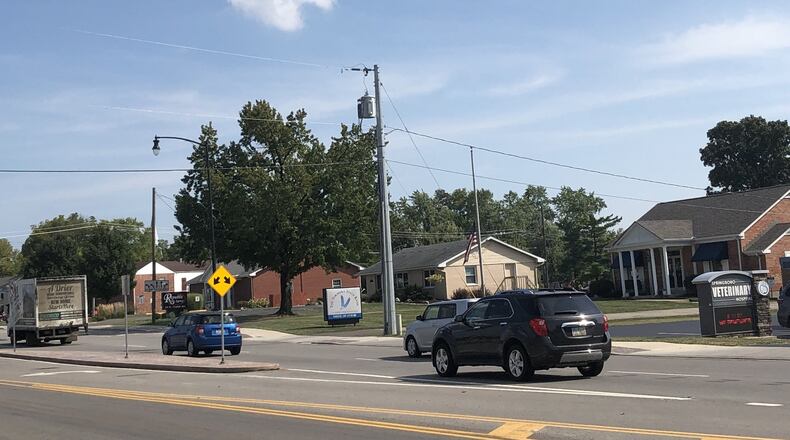The area of the proposed urban village is more than 10 times as large as the Wright Station development and encompasses existing businesses and homes.
Mixed-use developments, including residential uses, are envisioned.
The regulations are to be in place in January.
“We have one agenda item and it is a big one,” Becky Iverson, chairman of the Springboro Planning Commission and a city-council representative, said Wednesday as discussion began.
RELATED: Dayton-based Warped Wing brewery to build $3M facilities in Springboro
At the work session, the city’s staff planning consultant, Dan Boron, noted property on Central, across from Wright Station, was already the subject of “more speculation.”
Boron said the regulations were designed to protect the historic district south of the intersection, on and around Main Street, while “accommodating the development”of the land within the proposed 62-acre district.
The new performing arts center is expected to open next week.
In June, Warped Wing and city officials announced plans the Dayton-based microbrewery to build a restaurant, taphouse and pilot-beer microbrewery, and relocate distribution, at Wright Station.
Iverson explained the current regulations and review process made difficult and time-consuming developments like the one proposed by Warped Wing.
A map of the proposed urban village district includes an area continuing north on Main Street, Ohio 741 in Springboro, from the central intersection at Central Avenue, better known as Ohio 741.
The proposed village’s northern boundaries lie beyond Eleanor Drive on the west side of Main and Parker Drive on the east side of Main.
The proposed district also includes seven developed commercial properties on the south side of West Central, across from Wright Station.
It also would include seven homes on the northern edge of the area, although new single-family homes would not be among permitted land uses, according to 27 pages of proposed regulations.
The proposed urban village district would encompass an area roughly similar to what is known in local zoning regulations as Springboro’s Town Center District.
RELATED: Springboro performing arts center lands money in state budget
The town center district “was established in 1999 originally to protect the adjacent Historic District following a proposal to develop a drug store with a drive though on the southwest corner,” Boron said in the memo. “At the time only moderate design standards existed outside the Historic District for nonresidential development.”
The town center included the Springboro IGA Plaza, once the social center of Springboro. But it was eclipsed by commercial developments at Settlers Walk, on West Central and, most recently at Austin Landing, just across from Springboro city limits in Miami Twp., Montgomery County.
In 2015, the city bought the plaza after the supermarket closed and other buildings deteriorated.
Beginning in 2016, contractors demolished the buildings, along with the gas stations and auto repair shop on three corners of the intersection, taken for intersection improvements.
RELATED: Theater group looking forward to new home base in Springboro
The proposed urban village district regulations would be used in reviewing plans for development at Wright Station and the other 56 acres included in the proposed boundaries.
“The 6 acres at Wright Station will probably take 3-5 years to fully develop. The entire 62 acres will take as long as the private property owners desire to redevelop the properties,” City Manager Chris Pozzuto said in an email response to questions about the plans.
Among the properties that would be affected are businesses operated by Anderson Funeral Home, Watkins Heating & Cooling and Grismer Tire on North Main, across from Wright Station.
Charles Anderson, owner of the funeral home and school board member, indicated he was unaware of the plan. Randy Watkins of Watkins Heating & Cooling did not respond to an inquiry.
At last week’s meeting, Boron fielded questions from commissioners on the regulations, presented at the Aug. 28 meeting during staff comments, rather than as an agenda item.
A memo issued before Wednesday’s meeting indicated a moratorium was no longer proposed, while the regulation changes were pending.
Boron also laid out a proposed timeline for approval of the urban village district map and regulations by the end of January.
Boron said the proposal was “a direct outgrowth” of reaction to a community meeting on Wright Station last year.
He also said the urban village district proposal was related to a visit in March 2017 to a planned development in Perrysburg with developer Larry Dillin.
Dillin, who at one time expected to handle the Wright Station development, also worked with the city on proposed development of Austin South Springboro, across Austin Boulevard from Austin Landing.
RELATED: Springboro picks same developer for two projects
The city plans to allow existing single-family homes to remain within the urban village through “non-conformity” provisions in the proposed code changes.
According to the memo, the proposed regulations include “elements of a form-based code that places less emphasis on land use types in the place of build-to lines, number of floors, and building site frontage” and are “a hybrid of the form-based and conventional zoning.”
“This is a big change,” Boron said.
Planning Commissioner Becky Hartle noted the proposed regulations allowed buildings of up to four stories and one seven-story hotel.
RELATED: Springboro continues investing in crossroads development
Review by the city’s Architectural Review Board would no longer be required. Nor would Board of Zoning Appeals review be permitted, according to the memo prepared for Wednesday’s meeting.
“It’s trying to encourage organic development but in a more quick fashion,” Boron said at the meeting.
Unlike traditional developments, the buildings in the village would be expected to feature “four-sided architecture,” Boron added.
Developers following the regulations would not face rejection “without very good reason,” according to Boron.
“This is designed to make the zoning less punitive,” he said.
Boron also said there were no proposals pending for multi-story hotels and no other developments proposed except in the city-owned Wright Station development.
“This is not responding to anything,” he said.
Stephen Harding, the city council’s other representative, did not attend the planning commission work session. Harding refrained from council votes on the performing-arts center project due to potential conflicts.
The Springboro Chamber of Commerce, where he served on the board, and Harding’s mother’s business, Center Stage Dance Studio, are tenants in the Performing Arts Center.
RELATED: Springboro councilman has two potential conflicts, skips arts-center votes
The commission is expected to meet several more times to discuss the proposed urban village district zone.
All planning commission meetings are public.
The commission meeting scheduled for Wednesday, Oct 2, at 6 p.m., is designed for public input.
Assuming “sufficient consensus,” Boron said his timeline anticipated action by the planning commission
in October and approval by council in December, with the urban village district taking effect in January.
“That’s our goal,” Boron said.
Proposed Springboro Urban Village District Timeline
Wednesday, Oct. 2, Planning Commission public input
Wednesday, Oct. 9, Planning Commission work session
Thursday, Oct. 17, City Council sets public hearing for Thursday, Nov. 21
Wednesday, Oct. 30, Planning Commission formal recommendation to council
Thursday, Nov. 21, City Council public hearing, first reading of ordinance.
Dec. 5, City Council second reading.
Dec. 19, third reading, vote.
Jan. 19, 2020, effective date.
Most meetings begin at 6 p.m. For more information, call 937-748-4343.
Source: City of Springboro
About the Author

